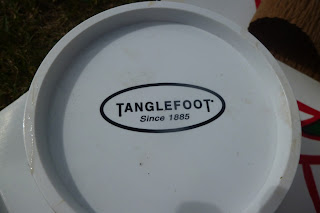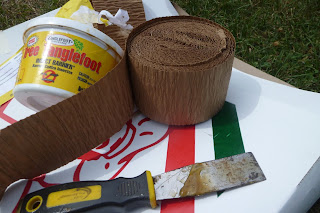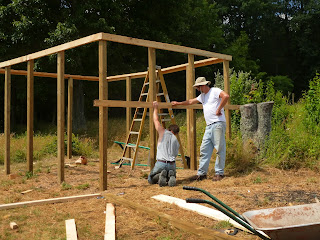Tree Tanglefoot for your Pear & other Trees
If you read my last post, "To Spray or Not to Spray," then you know my Asian pears are 100% organic. In fact to me, they are beyond "certified organic," because I sprayed nothing on them, not even allowable organic sprays. But I did use a barrier on the trunks to stop the ants that ruined some of my Hosui pears last summer.
I used Tree Tanglefoot and Tangle-Guard tree banding material and some twine to keep the ants from getting up the trunk and into the fruit hanging on the tree. The ants still hung around beneath the tree eating anything that fell from the tree, but they did not get up into the tree at all, which kind of surprised me, because I thought those buggers would find some way to get at those pears.
I ordered a 15 ounce tub of Tree Tanglefoot Insect Barrier and a 3 inch by 50 feet roll of Tangle-Guard Tree Banding Material. The Tanglefoot cost $10.99 and the Tangle-Guard was $5.99 both were from Amazon. The Tangle-Guard is a corrogated waterproof paper roll, and the TangleFoot is an oil-based, non-drying goop. Goop is my word choice. You don't want to get a bunch of this stuff on your hands, but it is OMRI rated and certified for organic gardening.
I thought that applying this was going to be a nightmare, but it wasn't. I got a pizza box from my porch some twine from the barn, and a putty knife from the shed and set off to do it. I weeded around the trunk, then I wrapped the trunk with the tree wrap a few times, making about a 6 inch wide band around the trunk, a few inches from the ground. I then loosely tied the paper to the trunk with some twine, then quickly applied a blob of the Tanglefoot onto the twine and "spackled" it onto the paper. Then I liberally applied the goop around the paper, being careful not to get it onto the trunk.
I did this for my Hosui and Korean pear trees, and I had zero problems with ants eating the pears. Last year the ants ruined about 1/4 of my Hosui pears. They just climb up there and eat holes into the pears. You really can't blame them, the pears are so sweet and juicy.
About halfway through the summer, I took off the old wrap and goop and put new ones on. I don't know if this was necessary, but I wasn't going to take any chances, because the ants were about, eating any pears that prematurely fell to the ground.
I still have most of the tub and wrap waiting for next year. It really doesn't take much of either product to protect a tree. I also plan to use this on my Black Tartarian Cherry tree, which is also an ant favorite, next year.
Here are some pictures of the "Tangle Products" and the Hosui pears which were the ants' favorites.


























